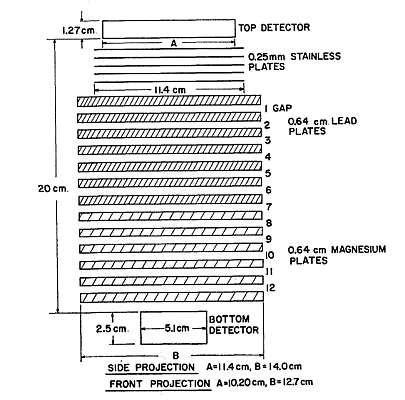Purpose of the flight and payload description
Goal of the flight was to measure the cosmic-ray electron flux using a lead-plate SPARK CHAMBER to detect the soft showers. The instrument was developed at the Case Institute of Technology, Cleveland, Ohio.
At left we can see an scheme of the spark chamber configuration. The chamber -constructed with multiple layers and housed in a machined Lucite box- contained two main sections: an upper thin-plate section and a lower thick-plate section. The upper section consisted of four gaps with stainless-steel plates that were 0.25 mm thick, designed to define the trajectory of particles before interaction. Below this was the thick-plate section containing 13 plates of 6.4 mm thickness with 6.4 mm gaps between them. The top seven of these thick plates were made of lead alloyed with approximately 10% antimony for stiffness, each providing about 1.1 radiation lengths to develop the electron shower. Following these were five magnesium plates of the same thickness to further study the developed shower. In total, the chamber offered about 8 radiation lengths or 54 g/cm² of material.
The chamber was sealed with O-rings to magnesium top and bottom plates and filled with a mixture of 90% neon and 10% helium at 20 psi pressure after being evacuated to 10?� Torr for three hours. The triggering system consisted of two plastic scintillators, one above and one below the chamber, set to detect single minimum ionizing particles. Two GP-17A spark gaps pulsed the chamber, one controlling the thin-plate chamber and upper six gaps of the thick-plate section, while the other controlled the lower six gaps. These spark gaps were triggered by a pulse amplifier system using an avalanche transistor, secondary emission hexode, and a hydrogen thyratron.
The high voltage system provided 5 kV and 10 kV through a multivibrator Cockcroft-Walton generator, housed in a pressurized spun-aluminum dome along with a 1.5-kV supply for the photomultipliers. Electrical connections were made through Tygon tubing filled with dry nitrogen at 1 atmosphere pressure. The chamber's operation was recorded through two 90° stereoscopic views using a 16-mm camera capable of taking 40,000 pictures.
When fully assembled with 2 inches of polyurethane thermal insulation, the complete spark-chamber gondola weighed 200 pounds.
Details of the balloon flight
Balloon launched on: 9/17/1964 at 17:24 cst
Launch site: Columbia Scientific Balloon Facility, Palestine, Texas, US
Balloon launched by: NCAR National Scientific Balloon Flight Station
Balloon manufacturer/size/composition: Zero Pressure Balloon 3.000.000 cuft
Balloon serial number: 2333-541-8201-S/N-199
Flight identification number: 68P
End of flight (L for landing time, W for last contact, otherwise termination time): 9/18/1964 at 7:00 cst
Balloon flight duration (F: time at float only, otherwise total flight time in d:days / h:hours or m:minutes - ): ~ 14 h
Landing site: 2 miles E of Cisco, Texas, US
External references
- Cosmic Ray Primary Electron Flux Measurement With Rigidity Above 5 Bv thesis by Smith L.H. - Case Inst. of Tech., Cleveland, Ohio (1965)
- Cosmic-Ray Electron Flux above 4.7 BV Physical Review, vol. 149, Issue 4, pp. 1013-1017
11775If you consider this website interesting or useful, you can help me to keep it up and running with a small donation to cover the operational costs. Just the equivalent of the price of a cup of coffee helps a lot.


